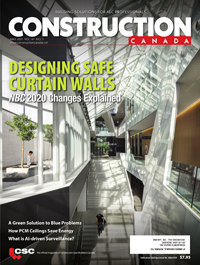Simplifying barrier-free design across Canada
Doors and door hardware
All doors in a barrier-free path of travel must be designed to include the following elements and features:
- clear width;
- latch-side clearances;
- door-manoeuvring clearances;
- door-opening force;
- clearances between vestibule doors;
- glass doors identified with opaque strips; and
- power door operators.
Figure 7 illustrates this.
Power door operators are not substantially discussed in this article, as they constitute a topic of their own. However, they are typically required to serve:
- entrances into buildings (select codes do not require power door operators at entrances, depending on the occupancy type and size of the building); and
- doors not provided with the required latch-side clearances.
Power door operators may also need to be installed on doors serving public-use washrooms or accessible hotel rooms, assembly occupancies serving Group C residential buildings, and outward-swinging doors for universal washrooms (Figure 8). However, each code differs when it comes to doors requiring these operators.
Where an existing door cannot achieve the required clear width, offset hinges or thinner door slabs can be installed. For best practice, door hardware should be colour-contrasting to the doorframe and physical door slab. Where a door opens into a barrier-free path of travel, one should provide a guard or barrier perpendicular to it to protect oncoming traffic (most applicable when the door is equipped with a power door operator).
It is worth noting able-bodied design professionals who have not tested a wheelchair device, mobility device, or mobility aid will never truly understand the complexity of navigating a doorway using such devices. The best way to understand barrier-free design is to go out and manoeuvre the world as an individual with a physical or sensory disability by using various mobility devices. For instance, one might use glasses simulating low- to no-vision capabilities and walk around with a walking cane, or mute any capabilities of hearing through soundless headphones and try to communicate. The codes require minimum barrier-free design requirements, but such requirements may not portray the reality of what is actually needed by someone with a disability.
Control height
Controls for the operation of building services or safety devices (e.g. electrical switches, thermostats, or intercom) intended to be operated by occupants and located within a barrier-free path of travel must be mounted at an accessible height, reachable by individuals using a wheelchair, and operable with minimal force (Figure 9).
Based on the Appendices of CAN/CSA B651-12, the average adult using a wheelchair can reach as high as 1400 mm (55 in.) from a side approach (i.e. parallel approach), and 1200 mm (47 in.) from a front approach (i.e. leaning forward). It is important to note not all wheelchair users have full mobility of their upper body, so reaching capabilities will vary. This criterion is also confirmed through anthropometry research completed by the Centre of Inclusive Design and Environment Access (IDeA) in Buffalo, New York. (For more information, see “What is Anthropometry?” from the Center for Inclusive Design and Environment Access [IDeA] at www.udeworld.com/anthropometrics.html.)
When considering the installation height of a control, three things must be considered:
- approach;
- reach; and
- location (i.e. within a barrier-free path of travel).
Controls and mechanisms unrelated to building services or safety devices—including, but not limited to, hand-sanitization stations, vending machines, bank machines, and parking-stub dispensers—should also be located between 900 and 1200 mm (35 and 47 in.) AFF to be considered accessible, with an appropriate clear floor space for approach (from 750 to 900 mm [29 to 35 in.] wide by 1200 to 1370 mm [47 by 54 in.] long).
The specified slider id does not exist.





